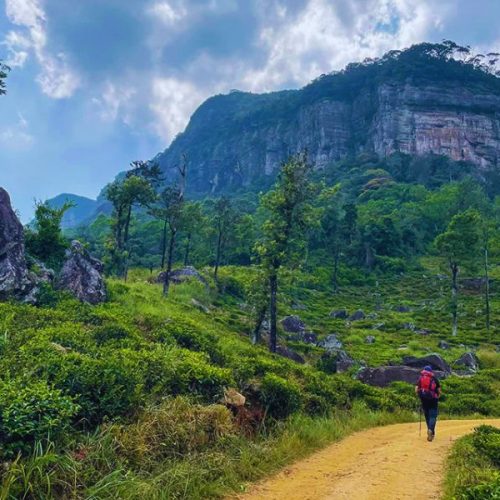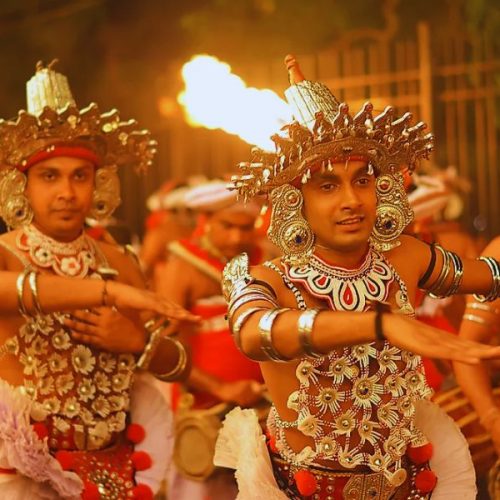Sri Lanka is a paradise for hiking and trekking enthusiasts. With its lush rainforests, misty mountains, scenic valleys, and cool highland climates, the island offers an array of hiking trails for all skill levels, from leisurely walks through tea estates to challenging climbs up rugged peaks. Whether you’re chasing breathtaking sunrises, ancient trails, or hidden waterfalls, Sri Lanka’s diverse terrain will leave you in awe.
The Pekoe Trail – Central Highlands (Kandy to Nuwara Eliya)
A new and internationally recognized long-distance walking trail, The Pekoe Trail spans over 300 kilometers through the heart of Sri Lanka’s tea country. Divided into 22 stages, it’s suitable for various fitness levels and can be hiked in its entirety or as single-day treks. The trail is well-marked with a dedicated app, guiding you through tea plantations, remote villages, and breathtaking landscapes.
Adam’s Peak (Sri Pada) – Ratnapura/Nuwara Eliya
One of Sri Lanka’s most revered pilgrimage sites, Adam’s Peak is known for the sacred footprint at the summit. The hike begins at night to reach the peak by sunrise. It’s a challenging climb with over 5,000 steps, offering a spiritually and visually uplifting experience. The official pilgrimage season runs from December to May, when the path is lit and crowded with fellow pilgrims.
Ella Rock – Ella
A favorite among backpackers, this hike is a medium-difficulty trek that takes about 2-3 hours. The trail offers panoramic views of Ella Gap, Little Adam’s Peak, tea plantations, and the surrounding hills. While it’s a popular hike, hiring a local guide is still recommended as some sections can be confusing.
Little Adam’s Peak – Ella
Easier and more accessible than Ella Rock, this gentle hike is perfect for beginners and families. The path winds through lush greenery and tea estates and rewards hikers with stunning views of the valley and Ella Rock itself. It’s a great option for a sunrise or sunset walk.
Horton Plains & World’s End – Nuwara Eliya
Located in a national park, this relatively flat trail is about 9.5 km round trip and passes through misty cloud forests and grasslands, culminating in a dramatic drop called “World’s End.” Start your hike early in the morning (by 6 or 7 a.m.) to beat the afternoon mists that can obscure the view.
Knuckles Mountain Range – Kandy/Matale
This UNESCO-listed biodiversity hotspot is a haven for adventurous trekkers. Multiple trails pass through remote villages, forests, and waterfalls. Guided treks are highly recommended due to the complexity of the terrain and for a deeper understanding of the unique ecosystems. The popular Dothalugala and Mini World’s End trails offer distinct experiences.
Pidurangala Rock – Sigiriya
This hike is a shorter alternative to climbing Sigiriya Rock and offers a spectacular panoramic view of the Sigiriya Fortress from the summit. The trail includes a mix of stone stairs and some bouldering toward the top, making it a fun and rewarding climb.
Sinharaja Rainforest Trails – Sabaragamuwa / Southern Province
UNESCO-listed Sinharaja offers guided nature trails through dense, ancient rainforest with rich biodiversity. Expect to see exotic birds, insects, reptiles, and endemic flora. A local guide is mandatory to navigate the protected reserve and spot its hidden wonders.
Kirigalpoththa – Horton Plains National Park
For seasoned hikers, Kirigalpoththa is Sri Lanka’s second-highest peak. This is a strenuous 14-kilometer round trip that is not for the faint of heart, but the rewarding views from the summit make it a must-do for experienced trekkers seeking a formidable challenge.
Bambarakanda Falls & Devil’s Staircase – Ohiya
This challenging trail takes you to Sri Lanka’s tallest waterfall, Bambarakanda, and includes a difficult segment known as the “Devil’s Staircase.” This hike is best for experienced hikers who are well-prepared for steep, rugged terrain and a long-distance trek.
Best Season
The dry season, from December to March, is generally the best time for hiking in the Central Highlands, as the weather is cooler and the trails are less muddy. However, the shoulder seasons of April-May and October-November can also be rewarding with fewer crowds and occasional showers. The pilgrimage season for Adam’s Peak runs from December to May.
What to Bring
Always carry sufficient water, high-energy snacks, a basic first-aid kit, and insect repellent. Wear sturdy hiking boots with good ankle support. Layered clothing is essential due to rapid weather changes, and a rain jacket is highly recommended for all seasons.
Guides
While popular trails like Little Adam’s Peak can be done solo, hiring a local guide is strongly recommended for difficult or remote treks like Knuckles, Sinharaja, and The Pekoe Trail. They not only ensure your safety but also provide valuable insights into the local flora, fauna, and culture.
Safety
Inform someone of your hiking route and expected return time. Mobile reception may be limited in remote areas. Be mindful of wildlife and local customs.
Eco-Friendly Practices
Respect the natural environment. Stick to marked paths, avoid littering, and do not disturb wildlife. Support local communities by using their services and purchasing local products.








